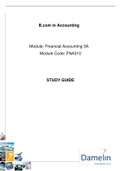Summary
Summary Summarized Financial Accounting year 3
- Course
- ICB FINANCIAL ACCOUNTING
- Institution
- Damelin (DCC)
Understand the financial risks, categorise the financial assets, financial liabilities; Be able to compound financial Instruments; Know derivatives, and reclassification of financial instruments; Understand the impairment of financial instruments, and be able to make disclosure...
[Show more]



